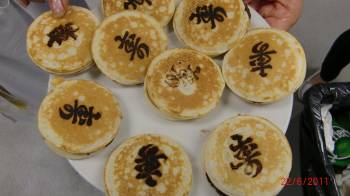A culinary adventure by Sabeen Abbas

The Japanese Canadian Cultural Centre (JCCC) is located just off the Don Valley Parkway at Wynford Drive. After a stop-and-go ride through post-work traffic, my mom and I arrive a few minutes late for Chef Shoji’s manju and mochi workshop at the JCCC. We sneak into the class as he demonstrates how to mix a paste for dorayaki – a red bean stuffed pancake. He shows us his kitchen tools – two heavy iron skillets with nine circular holes, branding irons with kanji characters. He drops the dorayaki mix made with flour, baking powder, eggs, milk, sugar, soya sauce, and mirin into the iron skillet. He has bent the length of his measuring spoon so that it hooks over his mixing bowl. When bubbles form on one side, he lifts up the pancake with a knife and flips them onto a hot tray to cook the other side. Chef Shoji is a retired auto mechanic who brings a methodical approach from his years of fixing cars to fixing up desserts. There is a tool for everything, he instructs us, and if there isn’t you have to make one.
Dorayaki, manju, and mochi are common Japanese sweets. Others include dango, daifuku, and taiyaki. They are all variations on a theme of pounded rice or rice flour and sweet red bean paste, called an or anko. The Japanese word for all sweet and savoury snacks is oyatsu, which means snack. Japanese style sweets are called wagashi and Western-inspired desserts, like cream puffs and strawberry shortcakes are called yogashi. Japanese sweets are generally less sweet than their Western counterparts, although equally heavy if not more in terms of carbs.
The highlight of Chef Shoji’s cooking class was learning how to make mochi. Mochi is traditionally made with pounded sticky rice and a red-bean filling. Different regions have adapted the basic recipe. For example, Sendai, Miyagi is famous for zunda mochi, which has a green soybean filling. During hanami, pink sakura mochi wrapped in a salted cherry leaf can be found in grocery stores.

In class, we learn how to make 10 minute strawberry flavoured mochi. The main ingredients are equal proportions of mochi-ko (sticky rice flour) and boiling water. The secret ingredient is a can of Strawberry Minute Maid. Making mochi is a bit like making play dough. Once the water (or juice concentrate) boils rapidly, you add the mochi-ko, remove from heat, and stir, stir, stir. The mixture offers plenty of resistance but you need to make it as smooth and lump-free as possible. Chef Shoji shows us how to slice the mochi into thin rectangles and fill with red bean paste before folding to make a ball. Finally it is time to try it for ourselves. It’s not as easy as it looks and it takes a lot longer than 10 minutes to assemble but fresh mochi in a Canadian kitchen is worth the effort.
